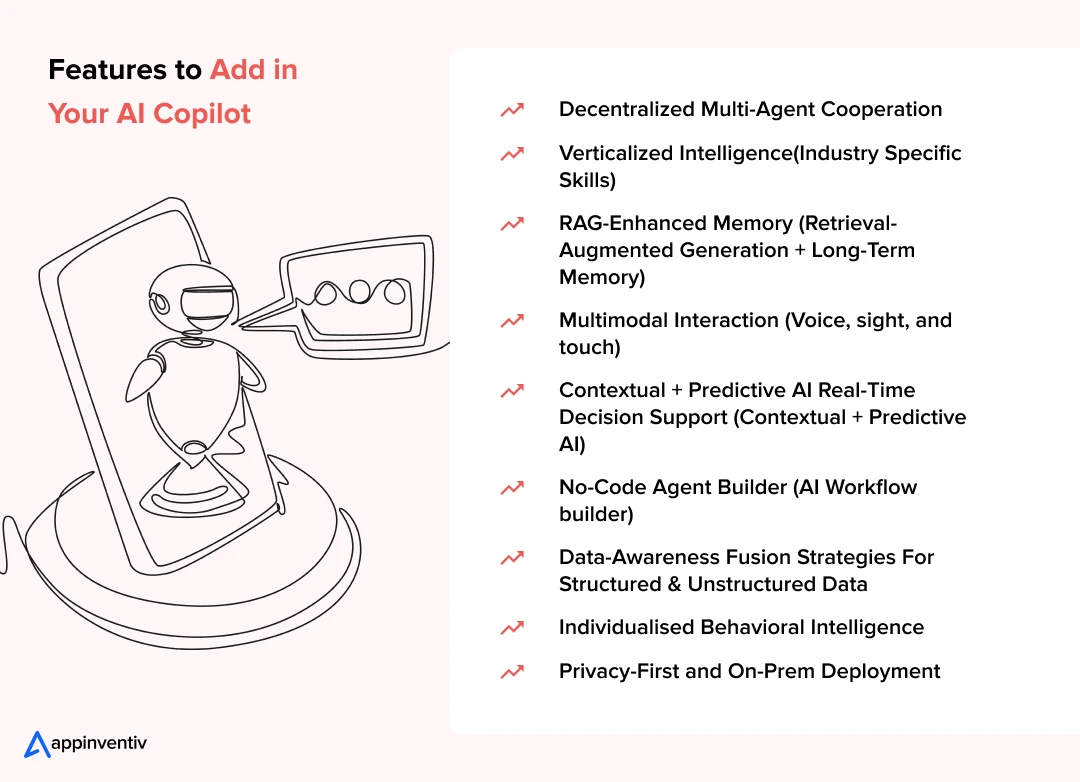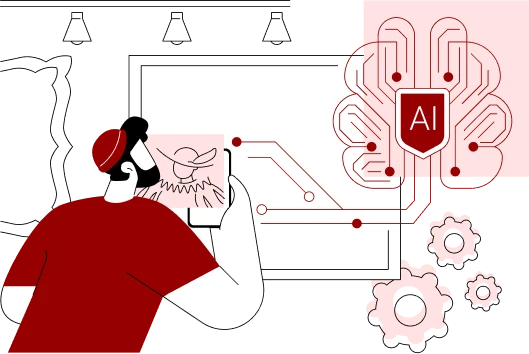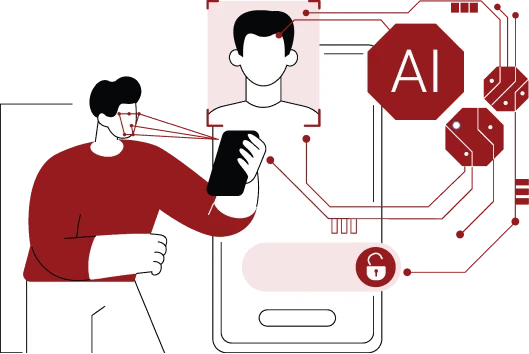Each day, a new type of power is taking shape in all of the modern enterprises—not data of cloud platforms, nor even the latest CRM—but the secret code, which enhances productivity and optimizes workflows, while promoting sharp increases in growth.
Well, you got it right – AI Copilot! With you, as a business leader, it is not a futuristic thing anymore; it is the competitive advantage, and this is the reason you have already made up your mind that you have to build.
However, the cold reality is that even the creation of an actual enterprise-level or AI copilot is bound to be a quest of not only technical difficulties. It is a strategic project that requires a sober view of the landscape.
It demands the need to go beyond the consumer-level hype around chatbots and adopt a much more integrated, securely controlled, and altogether unique system that aligns well with the intellectual property of your organization.
According to Fortune Business Insights, the global generative AI market size was valued at USD 43.87 billion in 2023 and is projected to grow from USD 67.18 billion in 2024 to USD 967.65 billion by 2032, exhibiting a CAGR of 39.6% during the forecast period. North America dominated the market with a share of 49.78% in 2023.
Industry leaders who are strategically deploying AI copilots are seeing a return on investment that redefines productivity and innovation. No sugar-coated talks, here’s the data that speaks volumes about AI Copilot implementation.
The question now isn’t if you should, but how you can do it right. This isn’t a guide on buying an off-the-shelf solution, but a deep dive into the detailed process to build an AI Copilot for enterprises, including trending and strategic features that will surpass your competitors’ AI Copilot projects. Let’s get to work.
Building AI Copilots for enterprise is a multi-phased process that is much more than the integration of an already available large language model (LLM). It must have a good comprehension of the needs of the organization, fine technical infrastructure, and an obsession with iteration to make the copilot add quantifiable value. Let’s explore the comprehensive steps to build an AI Copilot that will help increase productivity, streamline the workflow, and drive business success.
To build an AI Copilot for enterprises, you must have a clear strategic planning base since your AI Copilot is all about solving certain business problems and providing measurable value. To do this, you have to:
Consider your AI Copilot for Enterprises a smart helper, not a chat tool on steroids. The usability should be intuitive, clean, and simple.
This is the brain of your copilot. The model of LLM that you select would determine its features, prices, and performance.
Pro Tip: Leverage multi-agent architectures to simplify more complicated and multi-step tasks. This involves a main orchestrator agent that assigns sub-tasks to specialized agents (i.e., a “finance agent” or a “data agent”) to enable the copilot to complete a series of actions without human interaction.
An enterprise AI Copilot development needs a robust, scalable, and Secure enterprise Copilot architecture. It provides a smooth integration with the current systems, as well as good processing of even difficult tasks and stable performance in many functions. The development of such a system does not constitute a lump-sum approach but rather a complex coordination of more specific entities where each of them has a crucial role.
| Layer | Technologies/Tools | Purposes |
|---|---|---|
| Interface Layer | React, Flutter, WebSockets, Figma | Represents the interface that is available to the user, gives a comfortable human interface, and provides an adequate response in real-time. |
| Conversation Layer | LangChain, Semantic Kernel, Haystack | Processes and reads through the conversation, the agenda, and its status, where there is an exchange point with user input and the LLM. |
| Reasoning Engine | Open AI | The process of calling Agentic Frameworks enables the copilot to understand a complex request and break it into multiple processes to complete tasks. |
| Data Context | CMS APIs, CRMs, web, PDFs, emails, internal documentation | APIs Development makes the repository of proprietary and/or non-proprietary information accessible by the RAG for copilot system to provide contextual responses through actions. |
| Orchestration Layer | LLMOps platforms like LlamaIndex, LangGraph | Orchestrates the entire flow, including how it communicates with other models, tools, and enterprise systems. |
| Security & Compliance | OAuth 2.0, Role-based access, Data anonymization, Microsoft Purview | Protects sensitive data, ensures access control, and ensures its compliance with the regulatory principles (e.g., GDPR, HIPAA, SOC2). |
| Monitoring and Feedback | Prompt flow tracking, User feedback/User surveys, A/B advertising, Prometheus + Grafana | Monitor the performance and pinpoint issues, and also utilize user feedback to keep improving and revising the model. |
Refining Intelligence: Model Training and Human-in-the-Loop Design
To evolve beyond general application and to support enterprise-specific use cases, AI Copilots need to be refined constantly via specific model training and a well-developed Human-in-the-Loop (HITL) framework. This guarantees that not only is the AI smart but also precise, trustworthy, and business-focused.
Fine-tuning and Model Training
The foundation of honing the notions of an AI Copilot is data on training it and the consequent professional re-training.
- Domain-Specific Datasets: The Large Language Models (LLM) that are offered on-the-shelf tend to have been trained on extremely large, general datasets and may be poorly trained on knowledge that is specific to an industry, of interest to the enterprise.
- Generation of Synthetic Data: Synthetic data is generated by various computer systems that reflect patterns and statistical aspects of real data. The methods are transformations in Generative AI (such as GPT, GANs, and VAEs), rule engines, entity cloning, and data masking. It can be used as the training input to models to practice and perfect the skills with artificial data before putting such training to work in production.
Human-in-the-Loop (HITL) System Design
A collaborative strategy is referred to as Human-in-the-Loop (HITL) machine learning, where human skills and expertise are introduced in the lifecycle of AI systems. Human beings are actively involved in training using AI models, assessment, or running the AI models, which offers useful guidance, feedback, and the process of marking. Some of the important functions of a good HITL system are:
- Feedback cycles: To achieve this, it is necessary to establish how human beings can rectify model outputs to obtain an immediate indication of what must be improved.
- User-flagging: Enabling the ability of users to flag responses perceived to be hallucinated or biased, this allows reducing the overall biases found in data and algorithms to be identified and mitigated.
Fortifying Trust: Security, Privacy, and Compliance
In the case of enterprise AI Copilot development, privacy, security, and compliance are principles; they are not afterthoughts. Processing delicate company information and interactions between the user requires a sound structure that secures data, complies with the regulations, and fosters trust among the users.
The integration of AI Copilots into an enterprise setting is bound to process and store huge quantities of confidential data and information, such as proprietary business data, customer information, and employee records. Hence, it is essential to employ the strictest security and privacy provisions.
- End-to-End encryption E2BMC & Role-Based Access Control (RBAC): A healthy Role-Based Access Control (RBAC) scheme will allow only specified individuals to access certain information and various functionalities within the copilot system and prohibit anybody who has no rights to access such systems or data in them.
- Industry-Specific Compliance (SOC2, HIPAA, GDPR): The compliance with business and regional laws of interest to the industry needs to be maintained:
1. Healthcare enterprises need to make their artificial intelligence Copilot HIPAA-compliant, and it regulates the treatment of data as protected health information (PHI).
2. SOC2 requires financial enterprises to conform to practices that ensure service providers handle customer data following trust service criteria, including security, availability, and confidentiality of information.
- User-Level Segregation and Data Masking: Data masking and data anonymization techniques are essential in enabling the training of intelligent AI models on sensitive information without violating privacy. The methods involve substituting the personal information with pseudonyms or otherwise distorted values whilst maintaining the statistical facilities and features of the objective information, therefore guaranteeing confidentiality and preserving the statistical utility of the facts.
Bonus Read: A Complete Guide to Healthcare Compliance
Build Your HIPAA-Compliant App with Appinventiv
We’ve transformed healthcare with secure, scalable solutions like DiabeticU. Partner with us for HIPAA-compliant, AI-driven apps.
Monitoring & Measuring Performance
An efficient Copilot AI program requires an effortless framework of constant observation and learning. Traditional measures of initial success, including adoption rates and perceived time savings, are valuable, but long-term value comes in the form of continued operational efficiency and better business results. This has to involve monitoring of the quantitative measures as well as qualitative responses.
Key Metrics: There are several metrics to monitor the performance. These include:
In the case of Operational Indicators:
- Latency (response time)
- The cost efficiency of tokens (token usage)
- Uptime of the system
In case of Coding Assistants:
- Activity cycle time
- The throughput of the developer on pull requests
- Deployment frequency
In the case of Code Quality:
- Post-deployment incidence rates
- Rewriting by code reviews
- The status of change failure rates
User Satisfaction:
- Time savings, which are perceived
- Easy to use
- Emotional response
- Areas of development
Immediate Performance A/B Testing: Large Language Models (LLMs) require A/B testing to provide the best possible output quality and UI (user interface). It involves comparisons of immediate changes or model parameter calibration (e.g., temperature, context window sizes), aiming to reduce computational requirements and to ensure the best performance on real-world data. During these tests, there are metrics monitored in real-time, such as the response time and the accuracy.
Dashboards: It is essential to establish thorough dashboards that use measuring tools such as Prometheus for the collection of metrics and tools such as Grafana for the visualization of the uptime, quality, and the health of the whole system. Such dashboards give an overview of a central perspective of performance data, and anomalies can be spotted with ease.
Bonus Read: Guide to Mobile App Quality Assurance Process
Future-Proofing Your Investment: Trending Features to Add in Your Enterprise AI Copilot
To ensure that AI Copilot becomes a strategic asset that can enable a business to achieve a competitive edge, there should be not only the consideration of the current requirements but also the inclusion of more future-oriented features to become competitive. Such perspectives of looking forward make the copilot, not a supplier but a real creator of serious change.

Decentralized Multi-Agent Cooperation
Your copilot doesn’t just respond—it delegates and collaborates with other agents (e.g., finance agent, data agent, legal agent) to complete multi-step tasks. These systems are composed of distinct modules for specific tasks, facilitating efficient collaboration between agents. From beginning to end, these systems can manage entire processes autonomously while adapting to evolving conditions and datasets within enterprise workflows.
How this Feature Helps Enterprises:
- Businesses are integrating agentic AI in end-to-end model processes that are not manually interfered with.
- This feature enables companies to compress major volumes of work effectively, such as a month-long project, into a single day, and this presents a very powerful competitive advantage.
- It promotes responsiveness, productivity, and hardiness in the business processes.
Verticalized Intelligence(Industry Specific Skills)
This offers you pre-trained industry-specific workflows like finance, healthcare, logistics, or retail, which are built on deep, industry-specific expertise and are designed to understand the modulations and custom requirements of their targeted industry. They are further optimized using industry data sources, predictive models, and LLMs to offer very accurate and industry-relevant solutions.
How this Feature Helps Enterprises:
- Generic copilots are not up to the enterprise-specific tasks. Leaders select the vertical AI copilots (examples: EHRs, compliance review, fraud detection reviews).
- Vertical AI helps industries address any sophisticated, industry-specific challenge with specificity, resolve operational difficulties, automate industry-specific tasks, and increase productivity and effectiveness. This gives it a very high competitive advantage with wiser decisions and better customer exchanges.
Bonus Read: Ways Electronic Health Records Will Continue to Improve in 2025
RAG-Enhanced Memory (Retrieval-Augmented Generation + Long-Term Memory)
The purpose of this Feature is to incorporate the contextual memory with vector search. Your copilot can accurately cite previous communications and internal records as well as proprietary database(s). RAG for Copilots augments LLMs with the possibility to read information directly in real-time in external databases to give accurate and up-to-date answers. It enables the model to keep information on earlier exchanges and thus becomes more robust in ongoing dialog or goals that involve situational awareness throughout a series of inquiries.
How this Feature Helps Enterprises:
- Makes the responses relevant to a great extent, decreases the chances of hallucinations, and makes the user trustful.
- The availability of factual background helps RAG prevent the risks of creating false content by LLMs and guarantees the factual soundness and contextual content.
- That can be effectively used when it comes to chatbots in customer support, individual suggestions, where historical data can enhance relevancy.
Also Read: RAG vs Fine Tuning: Which AI Approach is Best for Your Business?
Multimodal Interaction (Voice, sight, and touch)
With this Multimodal AI Copilot features, People can communicate through speech, pictures, graphs, video, and even gestures. This entails models of AI devising ways of separating complex processes into deterministic steps of reasoning over multiple data types, for instance, by concatenating textual data along with raw sensor readings to yield semantic embeddings.
How this Feature Helps Enterprises:
- AI Copilots are switching to text-free UIs to be humanlike, and they are used most especially in design, healthcare, and education scenarios.
- This shifted the usage of copilots into combined systems, and they can expand experiences and increase applicability by blurring the existing boundaries between the virtual and real worlds.
Also Read: Top 10 Innovative Multimodal AI Applications and Use Cases
Contextual + Predictive AI Real-Time Decision Support (Contextual + Predictive AI)
Provides real-time recommendations during the process of examining operational results. This is done by analyzing past data, scenario simulation, aligning plans and business objectives, and providing real-time alerts. AI systems allow for real-time mode, proactive system design, and continuous adaptation.
How this Feature Helps Enterprises:
- Businesses do not need copilots that are merely helpers; they need advisors in real-time.
- This allows quicker and data-informed decision-making, agile roadmaps, and constant strategy adjustment, which in almost every field means wiser plans and allocation of resources.
No-Code Agent Builder (AI Workflow builder)
Enables the user to build or alter workflows with agents without writing code. Platforms like Lindy, Zapier, Make, and Budibase allow non-technical people to create smart and task-centered agents using a minimal set of logic and a drag-and-drop interface.
How this Feature Helps Enterprises:
- Your businesses demand copilots that they can customize.
- This will democratize the development and creation of AI systems in organizations, enable citizen developers to develop AI agents and solutions, and make copilots extremely customizable and accommodating to changing business demands.
Bonus Read: Is Low-Code No-Code the Future of Application Development?
Data-Awareness Fusion Strategies For Structured & Unstructured Data
It is a term used to describe the combination and analysis of both categorized data (traditional structured data: spreadsheets, relational databases) and unstructured data (text files, emails, social media posts, images, video files, sensor information). Your copilot must be able to work across both structured ERP/CRM data and unstructured documents, emails, and tickets.
How this Feature Helps Enterprises:
- The vast majority of AI copilots fail to interconnect such disparities of data, leaving them more harmful than beneficial.
- Compiling these types of data can be of greater benefit to consumer understanding, personalization, and optimization of experiences, resulting in thorough knowledge and actionable insights.
Also Read: Smart Data Discovery Applications and Benefits
Individualised Behavioral Intelligence
Adjusts to the user preference with time- learnt preferences in terms of task styles, tone, pacing, and approval workflow. This helps the system recognize user behavior patterns and create a more user-tailored experience. The system will know how to adapt the way tasks are communicated and converted to better suit the particular user.
How this Feature Helps Enterprises:
- The new UX is all about personalization, and the intelligent copilot will need to change accordingly.
- It culminates in more personalized and efficient support, providing improved resolutions at every touchpoint, and enhancing user engagement.
Privacy-First and On-Prem Deployment
Provides a choice to deploy privately (on-prem or VPC) and have high compliance (GDPR, HIPAA, SOC2). This will ensure that the business will be able to run its models at scale on dedicated servers with reduced reliance on centralized cloud servers and offer the business capability to perform real-time, localized inference on edge devices.
How this Feature Helps Enterprises:
- Business organizations are keen on AI copilots but will not accept a lower intimacy with their data and privacy.
- Installation of data anonymization as the foundation of data readiness protects sensitive data and intellectual property, making it compliant with regulations, and will help in developing customer goodwill.
Unlock the full potential of your AI Copilots!
Add custom features to create advanced, tailored solutions that elevate your productivity.
AI Copilot Development Cost for Enterprises
Enterprise AI Copilot development is a significant investment that requires careful budgeting and an understanding of both direct and indirect costs. The total AI Copilot development cost ranges from $45,000 to over $500,000+, depending heavily on complexity, customization, and the chosen deployment model.
Cost Estimation (Based on Complexity)
| Complexity Level | Description | Estimated Cost Range (USD) |
|---|---|---|
| Basic (Off-the-Shelf) | Integrating AI Copilots with existing systems, SaaS AI copilots (e.g., Microsoft 365 Copilot, GitHub Copilot) with minimal customization. | $30 – $40 per user/month (subscription) |
| Medium (Customization/RAG) | Building AI Copilots that are domain-specific using foundational LLMs with RAG for Copilots, custom UI, and limited integrations. | $45,000 – $250,000 (initial development) |
| High (Agentic/Complex) | Developing multi-agent systems, extensive fine-tuning, deep enterprise integrations, advanced multimodal features, and on-premise Enterprise Copilot deployment process. | $250,000 – $1,500,000+ (initial development) |
| Annual Recurring Costs (Custom) | Ongoing maintenance, LLM inference, data storage, infrastructure, and continuous improvement for custom solutions. | $350,000 – $820,000+ per app |
Cost Drivers for Enterprise AI Copilot
Understanding the primary cost factors in AI Copilot development is essential for effective budget allocation and resource planning.
| Cost Driver | Impact on Cost |
|---|---|
| LLM Selection & Usage | High: Proprietary LLMs (e.g., GPT-4o) and high token volume increase operational costs significantly. |
| Data Readiness & Quality | High: Often consumes more budget and time than model development. Lack of data is a top barrier. |
| RAG Implementation | Very High: Can cost $750,000-$1,000,000 for build, plus significant recurring costs. |
| Model Training & Fine-tuning | High: Requires compute resources and ongoing labor. |
| Architecture & Integration | High: Engineering lift to connect LLMs to CRMs, ERPs, etc., adds project time and costs. |
| UI/UX Development | Medium to High: Complexity increases with advanced features and custom interfaces. |
| Infrastructure (Compute & Storage) | High: Specialized hardware (e.g., NVIDIA H100) is expensive. Cloud costs are usage-based. |
| Security & Compliance | High: Requires manual audits, legal review, and engineering effort for safeguards. Non-compliance carries severe penalties. |
| Human-in-the-Loop (HITL) | Medium: Labor-intensive for review and quality assurance. |
| Maintenance & Monitoring | High (recurring): Models degrade over time, requiring regular updates and monitoring frameworks. |
| Talent Acquisition | High: Specialized AI talent is in high demand and costly. |
Hidden Costs
In addition to the direct line items, several hidden costs can play a significant role in the total cost of ownership and even prove to be the death of AI Copilot projects if not carefully considered. They can be based on the very complex nature of AI implementation in an organizational environment. The above table mentions these less evident but huge expenses that may blow up AI projects unless factored into more authentic budgeting.
| Hidden Cost | Impact on Project & Budget |
|---|---|
| Data Readiness | Significant time and budget drain; 39% of companies cite lack of data as a barrier. |
| Model Fine-tuning & Maintenance | Continuous labor and computing costs; models require regular updates to remain relevant. |
| Integration & Engineering Overhead | Adds substantial project time and costs, which are often underestimated. |
| Monitoring & Evaluation | Overlooked budget item; without it, risk degraded UX or decision failures. |
| Vendor Switching Costs | Rarely seamless, may require significant rework and unforeseen expenses. |
| Performance Optimization | Incurs extra development and infrastructure costs. |
| Governance, Risk, & Compliance (GRC) | Introduces hidden overhead; non-compliance carries severe penalties. |
| Hallucination Mitigation | This is a costly and labor-intensive engineering and QA effort. |
| Training & Organizational Change Management | Significant total cost of ownership; fear of job displacement can delay ROI. |
| Proof of Concept (PoC) Purgatory | 30% of GenAI projects halted after PoC. Wasted investment without production deployment. |
Strategic Cost Optimization for Enterprise AI Copilot Development
Companies can manage and reduce the overall cost of their AI Copilot initiatives in several key areas. The table below gives practical measures that companies should take to minimize the total price of their AI Copilot projects, striking the right balance between investment and performance.
| Strategy | How it Reduces Cost | Impact on Performance/Innovation |
|---|---|---|
| Target High-Value Use Cases | Maximizes return on investment; ensures resources are spent on impactful projects. | Focus AI development on processes with the highest potential for automation and ROI. |
| Leverage Open-Source LLMs & Tools | Reduces licensing fees for models (LLaMA, Mistral) and development tools. | Offers flexibility and customization; requires internal hosting and expertise. |
| Optimize Hardware & Compute | Explore GPUs (AWS Trainium, Google TPU) and use spot instances for training. | Significant reduction in infrastructure costs; may require managing instance interruptions. |
| Offload Edge Inference | Run simpler LLM tasks on client devices (e.g., mobile, desktop) instead of cloud servers. | Reduces cloud compute costs; potential latency/performance issues on older devices. |
| Utilize Cloud Discount Plans | Leverage Reserved Instances, Savings Plans, and enterprise discount programs from cloud providers. | Substantial savings on compute and storage; requires commitment and can lead to vendor lock-in. |
| Implement Autoscaling | Dynamically adjust compute resources based on workload demand, scaling down when idle. | Prevents over-provisioning and wasted spend; ensures resources are available when needed. |
| Prioritize RAG over Extensive Fine-tuning | Use RAG to ground LLMs in real-time data instead of costly, continuous full model retraining. | Improves accuracy and reduces hallucinations; more cost-effective for dynamic knowledge. |
| Adopt No-Code/Low-Code Platforms | Empower citizen developers to build and modify AI workflows, reducing reliance on specialized engineers. | Accelerates development, reduces labor costs; may have limitations for highly complex needs. |
Get Your Enterprise AI Copilot Cost Estimation
Consult our AI Development Cost Experts for a clear, tailored cost estimation. Start your AI journey today
Appinventiv: Your Trusted Partner For Custom AI Copilot Development for Enterprises
At Appinventiv, we are not the kind of software developers that would be content with developing simple software; we are the creators of AI services and solutions that would enable businesses to innovate and lead. We are one of the few companies with a deep expertise in the application of artificial intelligence, and our unwavering focus on the success of our clients makes us the best partner to scale your AI copilot vision to success.
Experience and Expertise can not be matched
- We are also composed of a force of 1600+ AI professionals and have expertise in data science, machine learning engineering, and software architecture to design cutting-edge AI.
- We are a success-paved road with more than 3000+ successful projects delivered to numerous clients across the globe. This vast experience does not simply constitute a figure but overcomes the technological challenges and achieves tangible and effective outcomes.
- We have experience in the type of Generative AI, machine learning, and natural language processing (NLP), and create clever systems that can bring value to productivity, automation capabilities, and strategic decision making.
- We are an ISO 9001/27001 certified enterprise, demonstrating our commitment to the strictest quality management practices and information security. This implies that your project is managed in a most serious and process-based manner that would protect your data and maintain the integrity of your solution throughout its implementation.
- Our continuous dedication to seamless IoT development has earned us international accolades and the highest honors in the awards space. These are clear recognitions of our continued commitment to delivering the best possible work to our clients.
AI Copilot Solutions Suite
Whether you are taking steps to improve a certain aspect of your operations or you are looking to add AI-powered capabilities across your business, our AI development services are scalable to suit your ambitious needs. We offer everything for AI Copilot full-stack development:
- Custom Copilot Development: We train bespoke AI copilots to integrate seamlessly into existing workflows as a smart assistant in tasks such as content generation, data analysis, and code creation.
- Generative AI Solutions: Our computer-based technology uses the capabilities of the large language models to generate copilots that will produce the text written in a human-like manner, the images, and the code with unprecedented efficiency and creativity.
- AI Consulting & Strategy: Our consultants guide you through the process of coming up with a concise AI strategy, finding the most suitable application of an AI copilot, and devising a plan to roll out and adopt successfully and properly.
- MLOps and Data Strategy: We make sure that your copilot has a strong base by offering you expertise in data collection, management, and the adoption of effective MLOps practices to sustain it, improve, and make its operations more efficient.
By choosing Appinventiv, you’re not just hiring a vendor—you’re partnering with a team that has the expertise, experience, and trust to turn your AI copilot aspirations into a powerful reality. We are ready to help you unlock new possibilities and drive your business forward.
FAQs
Q. How long does it take to build an AI Copilot for enterprises?
A. The process to build an AI Copilot for enterprises can take 3 to 12 months, depending on the complexity, size, and Customizable AI Copilot workflows in the project.
- Simple Copilots, that use pre-trained models and have very little customisation, can be made within 3-6 months, and will include integration of data and testing of simpler functionality.
- Building AI Copilots at Enterprise-level demand a significant amount of training on unique data, bespoke integrations to enterprise systems, and strong security practices, which can take 9- 12+ months or more.
Q. What data is needed to train an enterprise Copilot?
A. Training an enterprise Copilot involves both structured and unstructured data that is specific to the organization’s usage case. Some of the most important data types are:
- Manuals, SOPs, and knowledge bases that can provide the domain-specific context on an individual basis.
- Historical interaction data (ex, customer help logs, employee queries) to learn how the users behave.
- Data about a particular process in which transactional data exists (e.g., CRM or ERP).
- Feedback to correct the responses as time progresses.
- To be compliant, sensitive data either should be anonymized or treated under high governance (e.g., SOC 2 or ISO 27001).
Datasets used tend to be of high quality and quite diverse (usually tens of thousands and up to millions of records). They are further updated on an ongoing basis to stay relevant.
Q. Can AI Copilots work offline or on-premise?
A. AI Copilot implementation can be deployed on-premise or offline, depending on the Enterprise Copilot deployment process model. The on-premise Copilot is hosted in the client’s premises, which guarantees its data compliance with regulations like the GDPR or CCPA, which is pivotal in industries like healthcare or finance, to name a few. Offline features are dependent on the pre-trained models and local data storage, which restricts the possibilities of updating, but allows working in conditions of low connectivity.
Nevertheless, offline Copilots can be less capable, since they can not access cloud-based resources and live APIs to dynamic data. The hybrid models, where on-premise processing is combined with certain cloud-based access, provide a compromise between security and functionality. This is dependent on the organizational requirements, infrastructure, and security.
Q. Is enterprise AI Copilot development integration possible with existing enterprise software?
A. Yes, they are built to integrate with platforms like Salesforce, SAP, Microsoft Dynamics, and custom software. APIs and middleware ensure smooth data flow and compatibility with enterprise ecosystems.
Q. Which are the best AI Copilot platforms for enterprises in 2025?
A. Here’s the list of some of the best AI Copilot platforms for enterprises in 2025:
- Microsoft 365 Copilot: Integrates with Microsoft 365 apps (Word, Excel, Teams) for task automation, content generation, and data analysis, offering enterprise-grade security.
- GitHub Copilot: Enhances coding efficiency with context-aware code suggestions, ideal for development teams.
- Salesforce Einstein: Embeds AI into CRM for predictive insights and personalized customer interactions.
- Moveworks AI Assistant: Automates cross-application workflows with over 140 use cases, focusing on employee productivity.
- AWS Amazon Q: Streamlines software development and business operations within the AWS ecosystem.
- Google Cloud AI: Offers scalable infrastructure for building tailored AI Copilots.
- TextCortex: Customizable for content creation and coding, with GDPR-compliant infrastructure.
- IBM Watsonx Assistant: Excels in customer-facing chatbots with strong conversational capabilities.
Q. How is AI Copilot prototyping and testing conducted?
A. Testing involves evaluating the AI’s code suggestions for accuracy, relevance, and efficiency. This includes unit tests, integration tests, and user acceptance testing, where developers assess the tool’s performance in real-world coding scenarios.
Q. How to measure AI Copilot success metrics?
A. The success of AI Copilot implementation will have to be measured by keeping an eye on the quantitative and qualitative metrics according to business objectives. The most important ones are the following:
- User Adoption Rate: What proportion of employees/customers are utilizing the Copilot (e.g., 70% of the staff members are accessing it at least once every week).
- Efficiency of the job: Time or effort in performing is reduced (e.g., 30% faster response to customer queries).
- Accuracy/Relevance: Accuracy of responses, either the rating to be provided by the user or the error rate (e.g., 90 percent rate of accuracy of reactions).
- Cost Savings: The saved cost of carrying out efficient operations and a decrease in the necessity of hiring a human support staff.
- User thinning: Net Promoter Score (NPS) or user experience-based feedback survey.
- Business Impact: The results that can be measured in terms of an improved rate of conversion of sales or employee productivity.




















